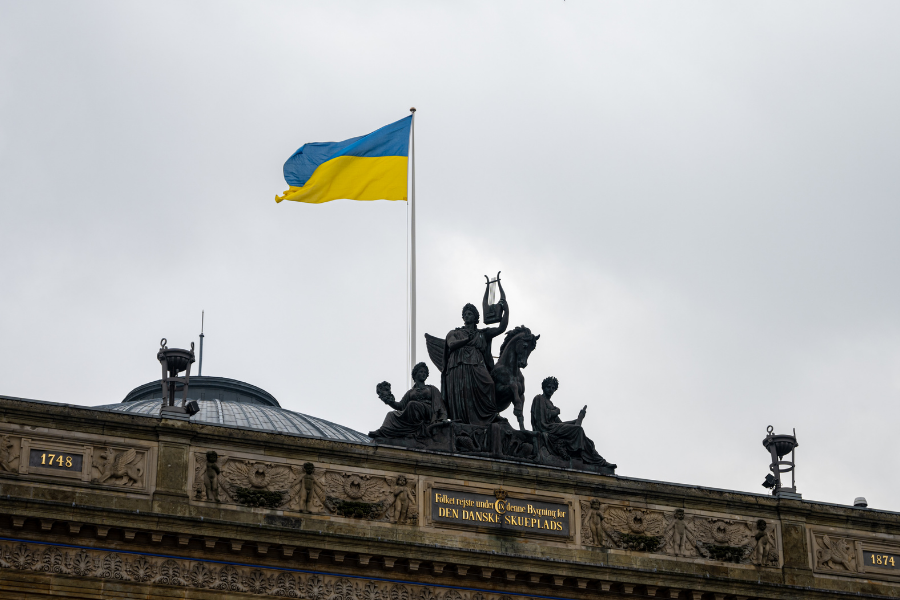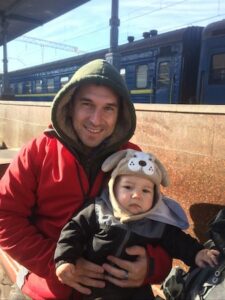
When Sergiy Omelayenko, CRNA, planned a trip to his home country of Ukraine, he’d intended to spend time with family. He also wanted to take his sister-in-law and young nephew to Poland, and from there fly with them to Boulder, Colorado, where his parents live. However, his plans changed dramatically following Russia’s invasion—and turned into an effort to help his family escape the war.
Eleven million people have now fled Ukraine, according to the United Nations.
Despite not being an official volunteer, as a nurse anesthetist Omelayenko knew he could help the medical professionals working on the front lines of care. He brought hundreds of donated medical supplies and a portable ultrasound machine with him. He’d bought the ultrasound machine to practice his skills after school. In Ukraine, he gave it to volunteers to donate where it was needed in Kharkiv.
“Any help was welcomed gladly,” he said. “On the front lines, technically I was working as a task-delegated individual and support in a busy environment. I was brought there by volunteers that deliver supplies and food who are able to travel through block posts.”

Sergiy Omelayenko with his nephew in Ukraine.
In the hospitals in Ukraine, all windows are barricaded. Patients are moved to hallways or away from windows. Bomb threat sirens go off three to four times a day. Hospital staff, along with their families, sleep in the basement, where it’s safer.
“Most of the staff, since the beginning of the war, stayed in the hospitals and lived in the hospitals, relying on volunteers to bring them supplies, food, water, and so on. They simply work 24 hours a day, every day. It is not only physically, but mentally exhausting,” Omelayenko said.
“They are working with very limited resources to provide care to injuries such as crush injuries, penetrating injuries from shrapnel, burn injuries. All these things require urgent/emergent care to try to save a victim’s life and limb. Unfortunately, there aren’t enough surgeons, there aren’t enough anesthesia professionals and other medical staff that can be available to respond to the significantly increased load that come in with life-threatening injuries.”
He said the wounds were usually “multiple and devastating, the result of shrapnel, bombs, high-velocity missiles, and mines (delivered by shelling). Children usually get injured by those, as they are curious.”
Omelayenko, a member of the American Association of Nurse Anesthesiology who practices in Florida, was a student of Michelle Canale, DNP, CRNA, APRN, the president-elect of the Florida Association of Nurse Anesthesiology, at the University of South Florida (USF)’s nurse anesthesia program. He was also the 2020 president of the Florida Association of Student Nurse Anesthetists. Thanks to his education and training at USF, he was more than equipped to step in to help, even in an austere environment.
“There were very basic anesthesia apparatus and next to no monitoring equipment, such as no ECG or EtCO2 monitors. BP cuffs, portable pulse oximeters, and stethoscopes are their primary monitors. Ventilation is with an Ambu bag and simple portable machines [that are] donations.”
He said he wishes he could have done more, but “all the credit goes to the physicians, anesthesiologists, nurses, respiratory therapists, medics, and Ukrainian people that found the courage to not only stay, but to volunteer and defend their country in numerous important ways. Ukrainian people are a very resilient and resourceful population and will make the best of any help provided by the west.”
Omelayenko said one thing U.S. medical providers can do, especially those who are familiar with caring for trauma patients, is offer free teaching or simulation on how to care for patients and make it available for Ukrainian medical professionals to improve their care during this time.
“The medical professionals that had to start caring for patients in the war are not particularly trained in trauma care … lots of professionals had to switch their expertise in a heartbeat. I think teaching is one of the biggest services we can give to these individuals, who stayed through all the dangers and hardship to heal the country.”
He also said there’s a desperate shortage of medical supplies. He said non-sterile equipment that would be thrown away in the U.S. is cleaned and reused due to the wartime shortage in Ukraine.
“There’s a list from the Minister of Health in Ukraine. It is updated constantly, and the help effort can be coordinated. Regular people in the U.S. can reach out to local organizations for medication donations.”
CRNAs have provided life-saving care during many wars, Omelayenko said, and he feels now is another time CRNAs can lead by example.
“In the Vietnam War, most front-line surgeries were performed under regional anesthesia, provided by nurse anesthetists. The Vietnam War, more than any previous conflict, gave a new face and a new character to anesthesia providers,” he said. “[Army nurse anesthetists] played a pivotal role in preserving life before, during, and after surgery. I feel like CRNAs of today can be role models in this conflict as well.”